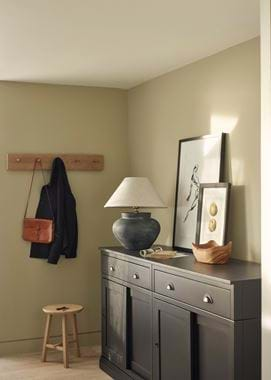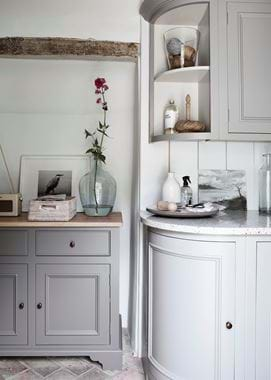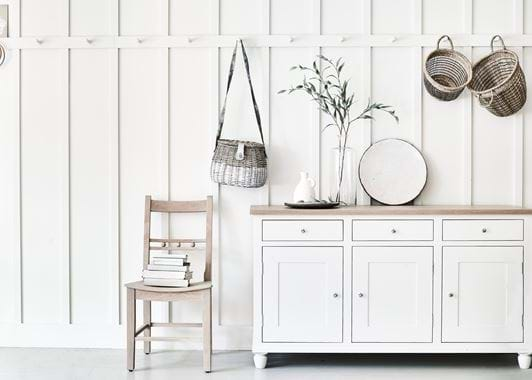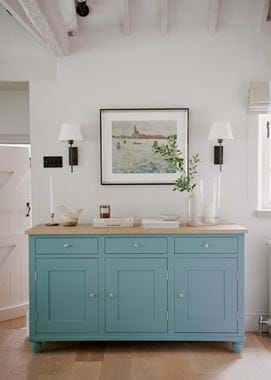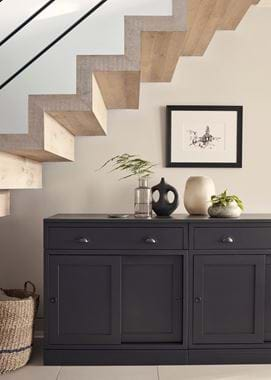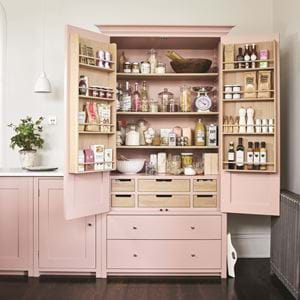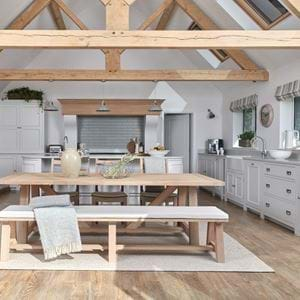In praise of sideboards – and why every home needs one
In praise of sideboards – and why every home needs one
Traditionally, sideboards were a feature of dining rooms, but in fact, they can hold their own almost anywhere. What’s great about them is that they give you storage and display space in one. Here are a few suggestions for how you might use one…
What does the word “sideboard” actually mean?
It’s one of those words we think we know, but that often gets confused with other items of furniture, like cabinets and dressers. The Oxford English Dictionary describes a sideboard as “a flat-topped piece of furniture with cupboards and drawers, used for storing crockery, glasses, and table linen.” They were popular in Victorian dining rooms, where they were often used for serving food next to the table, and so were also known as “buffets”.
Over time, their role has changed a bit. For a time, they were overlooked as old-fashioned, in favour of furniture like bookcases and dressers. But their combination of style and function – plus their slightly smaller scale, which fits well in modern homes – has brought about a revival. The rise of the Instagram “shelfie” display might be playing a part, too – the top of a sideboard is a great excuse to show off your favourite things.
Why might I choose one over shelves or a dresser?
There are a few reasons. Multi-purpose storage with a mix of drawers, cupboards and a display area is a smart choice if space is tight; open shelves or drawers alone might not quite do all the jobs you need them to.
Sideboards also have advantages in terms of looks. They’re elegant as well as practical – not something that’s always easy to achieve with storage – and are display objects in their own right. That makes them sit happily in all kinds of settings, from kitchens to “dressier” rooms like lounges and bedrooms.
The shape of a sideboard makes a huge difference to how it feels in a room. Sturdier, more solid shapes that sit close to the floor look more natural in functional spaces like kitchens; more refined shapes with longer, thinner legs are more fitting in a lounge or bedroom.
Low-level storage always has a lighter feel, too, which is another reason you might choose a sideboard over a dresser or bookcase. Tall furniture like this can feel bulky if your room has low ceilings or lacks natural light.
Where can I put one?
Beyond the obvious uses in living and dining rooms – and there’s nothing wrong with using a sideboard just like the Victorians did – sideboards are versatile, so there’s lots of potential.
At the smaller end, you can tuck a sideboard neatly under a window to get some extra use out of what could easily be a “dead” space. In this light-filled room, our Chichester bookcase base (which acts in a similar way to a sideboard) has been slotted between two built-in bookcases. As there’s room either side for display, it makes perfect sense to turn the top into a window seat – all that’s needed is a few cushions (you could get one made to fit to make it really comfy).
A sideboard with big cupboards is a great addition to a kitchen for storing bulkier items that you don’t want on display – think baking trays and blenders. This is how our Henley sideboard fits into the farmhouse kitchen pictured – there’s a separate dresser for crockery and cutlery. It’s worth noting that you can combine a sideboard and dresser if you only have space for one. The grey Suffolk in this dining room works this way – the sideboard part on the bottom is wider, so there’s still space to display things on top. It’s actually a kitchen base cabinet with a countertop one on top, but take them out of the kitchen and they’ll work just like a sideboard and bookcase, or “deconstructed” dresser.
A utility room is another option. The advantage here is that the top of the sideboard can be used like a worktop, while the cupboards keep laundry and cleaning products out of sight.
In a hallway, try a sideboard instead of a console table if you need more storage space. They might not work in the narrowest of hallways, but if the space is more open, they’re an easy way to keep it clutter-free and welcoming. Coat racks can be hung overhead (as in this home featuring our Suffolk sideboard), with the top used for things like mirrors, keys and post.
More surprisingly, we think sideboards can be wonderful in bedrooms. A dressing table might not feel useful enough, but a chest of drawers might be too bulky; a sideboard has the best elements of both.
Lastly, there’s also a trend for unexpected furniture in bathrooms. Here, a small sideboard is a different way to store toiletries, towels and scents. It looks pretty, but it’s practical – that’s what sideboards do best.

